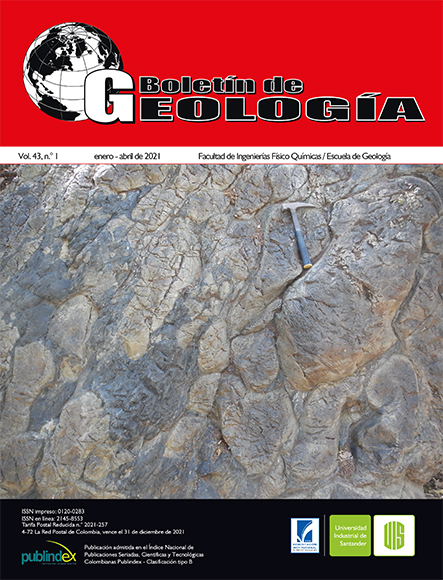Chemical classifiation and geothermometric of sulfies from the Pilar Mine gold deposit (Greenstone Belt, Quadrilátero Ferrífero, Brazil)
Published 2021-01-07
Keywords
- Quadrilátero Ferrífero,
- Sulphides,
- Mineral chemistry,
- Geothermometry
How to Cite
Copyright (c) 2021 Boletín de Geología

This work is licensed under a Creative Commons Attribution 4.0 International License.
Altmetrics
Abstract
The Quadrilátero Ferrífero is widely known for its world-class epigenetic and orogenic gold deposits of Archean ages. These are hosted in a sequence of meta-volcano sedimentary rocks of the Nova Lima group, mainly with the Banded Ferriferous Formations (BIF) and strongly sulfured with pyrite ± pyrrhotite ± arsenopyrite ± chalcopyrite + Au, where many of the mineralized bodies are structurally controlled due to the influence of regional NE structures and related to strongly hydrothermal zones. At the Pilar deposit, gold is disseminated in the Banded Iron Formation sequences and as free gold in quartz + carbonate veins associated with sulphides, mainly arsenopyrite. The main sulphides correspond to pyrrhotite, pyrite, chalcopyrite, and arsenopyrite, oriented according to a mylonitic S3 foliation of the rocks. Three halos of hydrothermal alteration are identified, distributed according to the position of the mineralized bodies, being chloritization zone (distal), carbonatization (intermediate) and sericitization (proximal). Chemical compositions of the sulfies associated with the hydrothermal mineral phases were carried out from the results obtained by electron microprobe analysis. The hydrothermal processes associated with the formation of mineralization, according to the paragenesis of sulphides (arsenopyrite ± pyrrhotite ± pyrite ± gold (electrum)) reveal a chemical equilibrium in the temperature range between 363°C to 471°C.
Downloads
References
Almeida, F.F.; Hasui, Y. (1984). O Pré-Cambriano do Brasil. Edgar Blücher Ltda.
Baltazar, O.F.; Zucchetti, M. (2007). Lithofacies associations and structural evolution of the Archean Rio das Velhas greenstone belt, Quadrilátero Ferrífero, Brazil: A review of the setting of gold deposits. Ore Geology Reviews, 32(3-4), 471-499. https://doi.org/10.1016/j.oregeorev.2005.03.021
Boyle, R.; Jonasson, I.R. (1973). The geochemistry of arsenic and its use as an indicator element in geochemical prospecting. Journal of Geochemical Exploration, 2(3), 251-296. https://doi.org/10.1016/0375-6742(73)90003-4
Clark, L.A. (1960). The Fe-As-S System-Phase relations and applications. Economic Geology, 55(7), 1345-1381. https://doi.org/10.2113/gsecongeo.55.7.1345
Eilu, P.; Groves, D.I. (2001). Primary alteration and geochemical dispersion haloes of Archaean orogenic gold deposits in the Yilgarn Craton: the pre-weathering scenario. Geochemistry: Exploration, Environment, Analysis, 1(3), 183-200. https://doi.org/10.1144/geochem.1.3.183
Etschmann, B.; Pring, A.; Putnis, A.; Grguric, B.A.; Studer, A. (2004). A kinetic study of the exsolution of pentlandite (Ni, Fe)9S8 from the monosulfide solid solution (Fe, Ni)S. American Mineralogist, 89(1), 39-50. https://doi.org/10.2138/am-2004-0106
Farina, F.; Albert, C.; Martínez-Dopico, C.; Aguilar-Gil, C.; Moreira, H.; Hippertt, J.P.; Cutts, K.; Alkmim, F.F.; Lana, C. (2016). The Archean-Paleoproterozoic evolution of the Quadrilátero Ferrífero (Brasil): Current models and open questions. Journal of South American Earth Scienses, 68, 4-21. https://doi.org/10.1016/j.jsames.2015.10.015
Groves, D.; Goldfarb, R.; Gebre-Mariam, M.; Hagemann, S.; Robert, F. (1998). Orogenic gold deposits: a proposed classification in the context of their crustal distribution and relationship to other gold deposit types. Ore Geology Reviews, 13(1-5), 7-27. https://doi.org/10.1016/S0169-1368(97)00012-7
Kant, W.; Warmada, I.; Idrus, A.; Setijadji, L.D.; Watanabe, K. (2012). Ore mineralogy and mineral chemistry of pyrite, galena, and sphalerite at Soripesa Prospect area, Sumbawa island, Indonesia. Journal of Applied Geology, 4(1), 1-14. https://doi.org/10.22146/jag.7191
Kretschmar, U.; Scott, S.D. (1976). Phase relations involving arsenopyrite in the system Fe-As-S and their application. The Canadian Mineralogist, 14(3), 364-386.
Le Vaillant, M.; Barnes, S.J.; Fiorentini, M.L.; Miller, J.; McCuaig, T.C.; Muccilli, P. (2015). A hydrothermal Ni-As-PGE geochemical halo around the Miitel komatiite-hosted nickel sulfide deposit, Yilgarn Craton, Western Australia. Economic Geology, 110(2), 505-530. https://doi.org/10.2113/econgeo.110.2.505
Marshak, S.; Alkmim, F.F.; Jordt-Evangelista, H. (1992). Proterozoic crustal extension and the generation of dome-and-keel structure in an Archaean granite-greenstone terrane. Nature, 357, 491-493. https://doi.org/10.1038/357491a0
Noce, C.M.; Machado, N. (1998). Eventos de cisalhamento e mineralização aurífera na região nordeste do Quadrilátero Ferrífero: Considerações baseadas em análises U-Pb de rutilo e titanita. Geonomos, 6(1), 21-24. https://doi.org/10.18285/geonomos.v6i1.161
Passos, R.V. (1999). Caracterização da geometria de zonas de alteração hidrotermal – Estudo de caso no depósito aurífero de Brumal, Quadrilátero Ferrífero/Minas Gerais. Tese de Mestrado, Universidade Estadual de Campinas, Brasil.
Ríos-Guerrero, J. (2016). Metalogênese do depósito aurífero Pilar, Santa Bárbara, MG. Tese de Mestrado, Universidade Federal do Amazonas, Brasil.
Schorscher, H.D. (1978). Komatiitos na estrutura Greenstone Belt Série Rio das Velhas, Quadrilátero Ferrífero, Minas Gerais, Brasil. Congresso Brasileiro de Geologia, Recife, Brasil.
Silva, L.C. (2007). Depósito Pilar: Contexto geológico, alteração hidrotermal e mineralização aurífera. Tese de Mestrado, Universidade Federal de Minas Gerais, Brasil.
Teixeira, W. (1985). A evolução geotectônica da porção meridional do Cratón do São Francisco, com base em interpretações geocronológicas. Tese de Doutoramento, Universidade de São Paulo, São Paulo, Brasil.
Vaughan, D.; Craig, J. (1997). Sulfide ore mineral stabilities, morphologies, and intergrowth textures. In: H.L. Barnes (ed). Geochemistry of Hydrothermal Ore Deposits (pp. 367-434). 3rd edition. Wiley-Interscience.
Vieira, F.W.R. (1991). Textures and processes of hydrothermal alteration and mineralization in the Nova Lima Group, Minas Gerais, Brazil. In: E.A. Ladeira (ed.). Brazil gold ´91, the economics, geology, geochemistry and genesis of gold deposits (pp. 319-325). Balkema, Rotterdam.
Xuexin, S. (1984). Minor elements and ore genesis of the Fankou lead-zinc deposit, China. Mineralium Deposita, 19(2), 95-104. https://doi.org/10.1007/BF00204667

